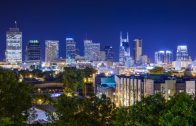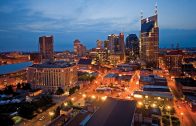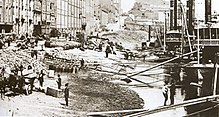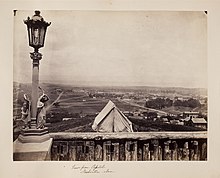Nasville, Tennessee
Nashville is the capital and most populous city of the U.S. state of Tennessee. The city is the county seat of Davidson County and is located on the Cumberland River.[6] It is the 23rd most-populous city in the United States.
Named for Francis Nash, a general of the Continental Army during the American Revolutionary War, the city was founded in 1779. The city grew quickly due to its strategic location as a port on the Cumberland River and, in the 19th century, a railroad center. Nashville seceded with Tennessee during the American Civil War; in 1862 it was the first state capital in the Confederacy to fall to Union troops. After the war, the city reclaimed its position and developed a manufacturing base.
Since 1963, Nashville has had a consolidated city-county government, which includes six smaller municipalities in a two-tier system. The city is governed by a mayor, a vice-mayor, and a 40-member metropolitan council; 35 of the members are elected from single-member districts, while the other five are elected at-large. Reflecting the city’s position in state government, Nashville is home to the Tennessee Supreme Court‘s courthouse for Middle Tennessee, one of the state’s three divisions.
A major center for the music industry, especially country music, Nashville is commonly known as “Music City”.[7] It is also home to numerous colleges and universities, including Tennessee State University, Vanderbilt University, Belmont University, Fisk University, Trevecca Nazarene University, and Lipscomb University, and is sometimes referred to as “Athens of the South” due to the large number of educational institutions.[8] Nashville is also a major center for the healthcare,[9] publishing,[10] banking,[11] automotive,[12] technology,[13] and transportation industries. Entities with headquarters in the city include AllianceBernstein,[14] Asurion,[15] Bridgestone Americas,[16] Captain D’s,[17] Dollar General,[18] Hospital Corporation of America,[19] LifeWay Christian Resources,[20] Logan’s Roadhouse,[21] and Ryman Hospitality Properties.[22]
18th and 19th centuries
In 1689, French-Canadian trader Martin Chartier established a trading post in 1689 on the Cumberland River, near the present-day site of the city.[23] In 1714, a group of French traders under the command of Charles Charleville established a settlement and trading post at the present location of downtown Nashville, which became known as French Lick. These settlers quickly established an extensive fur trading network with the local Native Americans, but by the 1740s the settlement had largely been abandoned.[24]
In 1779, explorers James Robertson and John Donelson led a party of Overmountain Men to the site of French Lick, and constructed Fort Nashborough. It was named for Francis Nash, the American Revolutionary War hero. Nashville quickly grew because of its strategic location as a port on the Cumberland River, a tributary of the Ohio River; and its later status as a major railroad center. By 1800, the city had 345 residents, including 136 enslaved African Americans and 14 free African Americans.[25] In 1806, Nashville was incorporated as a city and became the county seat of Davidson County, Tennessee. In 1843, the city was named as the permanent capital of the state of Tennessee.
The city government of Nashville owned 24 slaves by 1831, and 60 prior to the Civil War. They were “put to work to build the first successful water system and maintain the streets.”[26] Auction blocks and brokers’ offices were part of the slave market at the heart of the city.[26] It was the center of plantations cultivating tobacco and hemp as commodity crops, in addition to the breeding and training of thoroughbred horses, and other livestock. For years Nashville was considered one of the wealthiest southern capitals and a large portion of its prominence was from the iron business. Nashville led the south for iron production.[27]
The cholera epidemic that struck Nashville in 1849–1850 took the life of former U.S. President James K. Polk and resulted in high fatalities. There were 311 deaths from cholera in 1849[28][29] and an estimated 316 to about 500 in 1850.[30]
Before the Civil War, about 700 free Blacks lived in small enclaves in northern Nashville while there were over 3,200 Black slaves in the city.[31] By 1860, when the first rumblings of secession began to be heard across the South, antebellum Nashville was a prosperous city. The city’s significance as a shipping port and rail center made it a desirable prize for competing military forces that wanted to control the region’s important river and railroad transportation routes. In February 1862, Nashville became the first Confederate state capital to fall to Union troops, and the state was occupied by Union troops for the duration of the war. Then African Americans from Middle Tennessee fled to contraband camps around military installations in Nashville’s eastern, western, and southern borders. The Battle of Nashville (December 15–16, 1864) was a significant Union victory and perhaps the most decisive tactical victory gained by either side in the war; it was also the war’s final major military action in which Tennessee regiments played a large part on both sides of the battle. Afterward, the Confederates conducted a war of attrition, making guerrilla raids and engaging in small skirmishes, with the Confederate forces in the Deep South almost constantly in retreat.
In 1868, three years after the end of the Civil War, the Nashville chapter of the Ku Klux Klan was founded by Confederate veteran John W. Morton. He was reported to have initiated General Nathan Bedford Forrest into the vigilante organization.[32] Chapters of this secret insurgent group formed throughout the state and the South; they opposed voting and political organizing by freedmen, tried to control their behavior, and sometimes also attacked their White allies, including schoolteachers from the North.
Whites directed violence against freedmen and their descendants both during and after the Reconstruction era. Two freedmen, David Jones and Jo Reed, were lynched in Nashville by White mobs in 1872 and 1875, respectively.[33][34] Reed was hanged from a bridge over the river, but survived after the rope broke and he subsequently fell into the water, and fled the city soon thereafter.[35]
In 1873 Nashville suffered another cholera epidemic, along with towns throughout Sumner County along railroad routes and the Cumberland River. This was part of a larger epidemic that struck much of the United States. The epidemic is estimated to have killed around 1,000 people in Nashville.[36]
Meanwhile, the city had reclaimed its important shipping and trading position and developed a solid manufacturing base. The post–Civil War years of the late 19th century brought new prosperity to Nashville and Davidson County. Wealthy planters and businessmen built grand, classical-style buildings. A replica of the Parthenon was constructed in Centennial Park, near downtown.[37]
On April 30, 1892, Ephraim Grizzard, an African American man, was lynched in a spectacle murder in front of a White mob of 10,000 in Nashville.[38] His lynching was described by journalist Ida B. Wells as: “A naked, bloody example of the blood-thirstiness of the nineteenth century civilization of the Athens of the South.”[39] His brother, Henry Grizzard, had been lynched and hanged on April 24, 1892, in nearby Goodlettsville as a suspect in the same assault incident. From 1877 to 1950, a total of six lynchings of Blacks were conducted in Davidson County, four before the turn of the century.[40]
Earlier 20th century
By the turn of the century, Nashville had become the cradle of the Lost Cause of the Confederacy. The first chapter of the United Daughters of the Confederacy was founded here, and the Confederate Veteran magazine was published here. Most “guardians of the Lost Cause” lived Downtown or in the West End, near Centennial Park.[41]
At the same time, Jefferson Street became the historic center of the African American community, with similar districts developing in the Black neighborhoods in East and North Nashville. In 1912, the Tennessee Agricultural and Industrial and Normal School was moved to Jefferson Street.[31] The first Prince’s Hot Chicken Shack originated at the corner of Jefferson Street and 28th Avenue in 1945.[31] Jefferson Street became a destination for jazz and blues musicians,[31] and remained so until the federal government split the area by construction of Interstate 40 in the late 1960s.[42]
In 1950 the state legislature approved a new city charter that provided for the election of city council members from single-member districts, rather than at-large voting. This change was supported because at-large voting required candidates to gain a majority of votes from across the city. The previous system prevented the minority population, which then tended to support Republican candidates, from being represented by candidates of their choice; apportionment under single-member districts meant that some districts in Nashville had Black majorities. In 1951, after passage of the new charter, African American attorneys Z. Alexander Looby and Robert E. Lillard were elected to the city council.[43]
With the United States Supreme Court ruling in 1954 that public schools had to desegregate with “all deliberate speed”, the family of student Robert Kelley filed a lawsuit in 1956, arguing that Nashville administrators should open all-White East High School to him. A similar case was filed by Reverend Henry Maxwell due to his children having to take a 45-minute bus ride from South Nashville to the north end of the city. These suits caused the courts to announce what became known as the “Nashville Plan”, where the city’s public schools would desegregate one grade per year beginning in the fall of 1957.[31]
Urban redevelopment accelerated over the next several decades, and the city grew increasingly segregated. An interstate was placed on the edge of East Nashville while another highway was built through Edgehill, a lower-income, predominantly minority community.[31]
Postwar development to present
Rapid suburbanization occurred during the years immediately after World War II, as new housing was being built outside city limits. This resulted in a demand for many new schools and other support facilities, which the county found difficult to provide. At the same time, suburbanization led to a declining tax base in the city, although many suburban residents used unique city amenities and services that were supported financially only by city taxpayers. After years of discussion, a referendum was held in 1958 on the issue of consolidating city and county government. It failed to gain approval although it was supported by the then-elected leaders of both jurisdictions, County Judge Beverly Briley and Mayor Ben West.[44]
Following the referendum’s failure, Nashville annexed some 42 square miles of suburban jurisdictions to expand its tax base. This increased uncertainty among residents, and created resentment among many suburban communities. Under the second charter for metropolitan government, which was approved in 1962, two levels of service provision were proposed: the General Services District and the Urban Services District, to provide for a differential in tax levels. Residents of the Urban Services District had a full range of city services. The areas that made up the General Services District, however, had a lower tax rate until full services were provided.[44] This helped reconcile aspects of services and taxation among the differing jurisdictions within the large metro region.
In the early 1960s, Tennessee still had racial segregation of public facilities, including lunch counters and department store fitting rooms. Hotels and restaurants were also segregated. Between February 13 and May 10, 1960, a series of sit-ins were organized at lunch counters in downtown Nashville by the Nashville Student Movement and Nashville Christian Leadership Council, and were part of a broader sit-in movement in the southeastern United States as part of an effort to end racial segregation of public facilities.[45] On April 19, 1960, the house of Z. Alexander Looby, an African American attorney and council member, was bombed by segregationists.[46] Protesters marched to the city hall the next day. Mayor Ben West said he supported the desegregation of lunch counters, which civil rights activists had called for.[47]
In 1963, Nashville consolidated its government with Davidson County, forming a metropolitan government. The membership on the Metro Council, the legislative body, was increased from 21 to 40 seats. Of these, five members are elected at-large and 35 are elected from single-member districts, each to serve a term of four years.[44] In 1957 Nashville desegregated its school system using an innovative grade a year plan, in response to a class action suit Kelly vs. Board of Education of Nashville. By 1966 the Metro Council abandoned the grade a year plan and completely desegregated the entire school system at one time.[48]
Congress passed civil rights legislation in 1964 and 1965, but tensions continued as society was slow to change. On April 8, 1967, a riot broke out on the college campuses of Fisk University and Tennessee State University, historically Black colleges, after Stokely Carmichael spoke about Black Power at Vanderbilt University.[49] Although it was viewed as a “race riot”, it had classist characteristics.[49]
In 1979, the Ku Klux Klan burnt crosses outside two African American sites in Nashville, including the city headquarters of the NAACP.[50]
Since the 1970s the city and county have undergone tremendous growth, particularly during the economic boom of the 1990s under the leadership of then-Mayor and later-Tennessee Governor, Phil Bredesen. Making urban renewal a priority, Bredesen fostered the construction or renovation of several city landmarks, including the Country Music Hall of Fame and Museum, the downtown Nashville Public Library, the Bridgestone Arena, and Nissan Stadium.[51][52]
Nissan Stadium (formerly Adelphia Coliseum and LP Field) was built after the National Football League‘s (NFL) Houston Oilers agreed to move to the city in 1995. The NFL team debuted in Nashville in 1998 at Vanderbilt Stadium, and Nissan Stadium opened in the summer of 1999. The Oilers changed their name to the Tennessee Titans and finished the season with the Music City Miracle and a close Super Bowl game.[53] The St. Louis Rams won in the last play of the game.[54]
In 1997, Nashville was awarded a National Hockey League expansion team; this was named the Nashville Predators.[55] Since the 2003–04 season, the Predators have made the playoffs in all but three seasons. In 2017, they made the Stanley Cup Finals for the first time in franchise history, but ultimately fell to the Pittsburgh Penguins, 4 games to 2, in the best-of-seven series.[56]
21st century
On January 22, 2009, residents rejected Nashville Charter Amendment 1, which sought to make English the official language of the city.[57]
Between May 1 and 7, 2010, much of Nashville was extensively flooded as part of a series of 1,000 year floods throughout Middle and West Tennessee. Much of the flooding took place in areas along the Cumberland and Harpeth Rivers and Mill Creek, and caused extensive damage to the many buildings and structures in the city, including the Grand Ole Opry House, Gaylord Opryland Resort & Convention Center, Opry Mills Mall, Schermerhorn Symphony Center, Bridgestone Arena, and Nissan Stadium. Sections of Interstate 24 and Briley Parkway were also flooded. Eleven people died in the Nashville area as a result of the flooding, and damages were estimated to be over $2 billion.[58]
The city recovered after the Great Recession. In March 2012, a Gallup poll ranked Nashville in the top five regions for job growth.[59] In 2013, Nashville was described as “Nowville” and “It City” by GQ, Forbes, and The New York Times.[60][61][62]
Nashville elected its first female mayor, Megan Barry, on September 25, 2015.[63] As a council member, Barry had officiated at the city’s first same-sex wedding on June 26, 2015.[64]
In 2017, Nashville’s economy was deemed the third fastest-growing in the nation,[65] and the city was named the “hottest housing market in the US” by Freddie Mac realtors.[66] In May 2017, census estimates showed Nashville had passed Memphis to become most populated city in Tennessee.[67] Nashville has also made national headlines for its “homelessness crisis”. Rising housing prices and the opioid crisis have resulted in more people being out on the streets: as of 2018, between 2,300 and 20,000 Nashvillians are homeless.[68]
On March 6, 2018, due to felony charges filed against Mayor Barry relating to the misuse of public funds, she resigned before the end of her term. A special election was called. Following a ruling by the Tennessee Supreme Court, the Davidson County Election Commission set the special election for May 24, 2018, to meet the requirement of 75 to 80 days from the date of resignation.[69] David Briley, who was Vice Mayor during the Barry administration and Acting Mayor after her resignation, won the special election with just over 54% of the vote,[70] becoming the 70th mayor of Nashville.[71]
On May 1, 2018, voters rejected Let’s Move Nashville, a referendum which would have funded construction of an $8.9 billion mass transit system under the Nashville Metropolitan Transit Authority, by a 2 to 1 margin.[72]
On March 3, 2020, a tornado tracked west to east, just north of the downtown Nashville area, killing at least 25 people and leaving tens of thousands without electricity. Neighborhoods impacted included North Nashville, Germantown, East Nashville, Donelson, and Hermitage.[73]
On December 25, 2020, a vehicle exploded on Second Avenue, killing the perpetrator and injuring eight others.[74]
Geography
Topography
Nashville lies on the Cumberland River in the northwestern portion of the Nashville Basin. Nashville’s elevation ranges from its lowest point, 385 feet (117 m) above sea level at the Cumberland River,[75] to its highest point, 1,163 feet (354 m) above sea level in the Radnor Lake State Natural Area.[76][77] Nashville also sits at the start of the Highland Rim, a geophysical region of very hilly land. Because of this, Nashville is very hilly. Nashville also has some stand alone hills around the city such as the hill on which the Tennessee State Capitol building sits. According to the United States Census Bureau, the city has a total area of 527.9 square miles (1,367 km2), of which 504.0 square miles (1,305 km2) of it is land and 23.9 square miles (62 km2) of it (4.53%) is water.
Cityscape
Nashville’s downtown area features a diverse assortment of entertainment, dining, cultural and architectural attractions. The Broadway and 2nd Avenue areas feature entertainment venues, night clubs and an assortment of restaurants. North of Broadway lie Nashville’s central business district, Legislative Plaza, Capitol Hill and the Tennessee Bicentennial Mall. Cultural and architectural attractions can be found throughout the city.
Three major interstate highways (I-40, I-65 and I-24) converge near the core area of downtown, and many regional cities are within a day’s driving distance.
Nashville’s first skyscraper, the Life & Casualty Tower, was completed in 1957 and launched the construction of other high rises in downtown Nashville. After the construction of the AT&T Building (commonly referred to by locals as the “Batman Building”) in 1994, the downtown area saw little construction until the mid-2000s. The Pinnacle, a high rise office building, opened in 2010, the first Nashville skyscraper completed in more than 15 years.[78] Ten more skyscrapers have since been constructed or are under construction.
Since 2000, Nashville has seen two urban construction booms (one prior to the Great Recession and the other after) that have yielded multiple high-rises (defined by Emporis as buildings of a minimum of 115 feet tall). Of the city’s 37 towers of 280 feet tall or taller, 24 have been completed since 2000.
Many civic and infrastructure projects are being planned, in progress, or recently completed. A new MTA bus hub was recently completed in downtown Nashville, as was the Music City Star pilot project. Several public parks have been constructed, such as the Public Square. Riverfront Park is scheduled to be extensively updated. The Music City Center opened in May 2013. It is a 1,200,000 square foot (110,000 m2) convention center with 370,000 square feet (34,000 m2) of exhibit space.



















